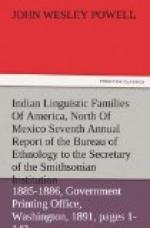[] Aleuten, Holmberg, Ethnog. Skizzen d. Voelker Russ. Am., 1855.
> Aleutians, Dall in Proc. Am.
Ass., 266, 1869. Dall, Alaska and
Resources, 374, 1870 (in both places a
division of his Orarian
family).
> Aleuts, Keane, App. Stanford’s
Comp. (Cent. and So. Am.), 460, 1878
(consist of Unalaskans of mainland and
of Fox and Shumagin Ids., with
Akkhas of rest of Aleutian Arch.).
> Aleut, Bancroft, Nat. Races, III,
562, 1882 (two dialects, Unalaska
and Atkha).
> Konjagen, Holmberg, Ethnograph.
Skizzen Volker Russ. Am., 1855
(Island of Koniag or Kadiak).
= Orarians, Dall in Proc. Am.
Ass., 265, 1869 (group name; includes
Innuit, Aleutians, Tuski). Dall,
Alaska and Resources, 374, 1870. Dall
in Cont. N.A. Eth., 1, 8, 9,
1877.
X Tinneb, Dall in Proc. Am. Ass., 269, 1869 (includes “Ugalense").
> Innuit, Dall in Cont. N.A.
Eth., 1, 9, 1877 ("Major group” of
Orarians: treats of Alaska Innuit
only). Berghaus, Physik. Atlas, map
73, 1887 (excludes the Aleutians).
Derivation: From an Algonkin word eskimantik, “eaters of raw flesh.”
GEOGRAPHIC DISTRIBUTION.
The geographic boundaries of this family were set forth by Gallatin in 1836 with considerable precision, and require comparatively little revision and correction.
In the linear extent of country occupied, the Eskimauan is the most remarkable of the North American linguistic families. It extends coastwise from eastern Greenland to western Alaska and to the extremity of the Aleutian Islands, a distance of considerably more than 5,000 miles. The winter or permanent villages are usually situated on the coast and are frequently at considerable distances from one another, the intervening areas being usually visited in summer for hunting and fishing purposes. The interior is also visited by the Eskimo for the purpose of hunting reindeer and other animals, though they rarely penetrate farther than 50 miles. A narrow strip along the coast, perhaps 30 miles wide, will probably, on the average, represent Eskimo occupancy.
Except upon the Aleutian Islands, the dialects spoken over this vast area are very similar, the unity of dialect thus observable being in marked contrast to the tendency to change exhibited in other linguistic families of North America.
How far north the east coast of Greenland is inhabited by Eskimo is not at present known. In 1823 Capt. Clavering met with two families of Eskimo north of 74 deg. 30’. Recent explorations (1884-’85) by Capt. Holm, of the Danish Navy, along the southeast coast reveal the presence of Eskimo between 65 deg. and 66 deg. north latitude. These Eskimo profess entire ignorance of any inhabitants north of themselves, which may be taken as proof that if there are fiords farther up the coast which are inhabited there has been no intercommunication in recent times at least between these tribes and those to the south. It seems probable that more or less isolated colonies of Eskimo do actually exist along the east coast of Greenland far to the north.




